#the society of the myriad tribe???
Text
live footage of mona plotting out niv's story:
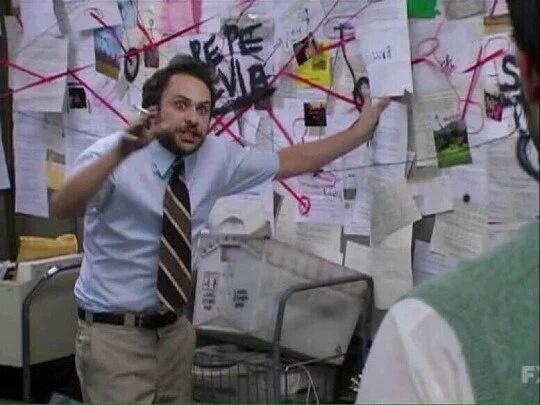
#im sorry to everyone i accidentally annoy with my unhinged/chaotic thoughts about this story#i just get so feral over the symbolism behind it and behind every single character#niv the rebel??? klaus the dreamer??? olga and her tradition??? magni and his loyalty???#plus the forrad brothers who i can't shut up about???#the society of the myriad tribe???#adults keeping their mouths shut for the sake of their children??? or so they think???#the unnamed chief??????#the silly debate among the kids if dragons are real bc they have never seen any???? niv thinking hiccup is a mythological figure????#potential gussiri mention even if they aren't in the fic??????#i hate and love this story at the same time#it's so deep so keeping the core is the most important thing#and the core is “only the strong belong” and the idea of freedom#very book httyd coded i just realised#slay#anyway i will keep going feral over this the next days just watch me#httyd#oc#niv larson#klaus#olga#magni#bendik forrad#ludvig forrad
6 notes
·
View notes
Text
@lynettethemadscientist replied to your post “me: narratively, it's much more interesting to...”:
I’m willing to hear a humanized view of Raiders. Though I doubt it will convince me
Sure, I'll expand on this. Point of note, this is pretty West Coast/FNV-centric since that's my primary area of interest.
Let's start with defining terms since this is the piss-on-the-poor website. A raider is a bandit, someone who survives by plunder, often roaming in search of things to steal or people to attack. Many raider gangs in the Wasteland are relatively loose allegiances of a few like-minded individuals, but some are established social groups with distinct cultures. The 80s, the Vipers, and the Khans are examples of raider groups that expanded to fit the definition of a tribe—that is, a social division consisting of families or communities linked by social, economic, religious, or blood ties, with a common culture and dialect.
The 80s, first outlined in Joshua Sawyer's rpg, are a gang of bandits that operate along the Northern California 80 Freeway and have long contested territory with the White Legs; The Vipers are organized around their shared religion, which is only vaguely described as ancient, but there are what appear to be ritualistic elements to their organization and raiding practices.
The Khans, inspired by Genghis Khan and the Mongols Motorcycle Club, value strength and martial prowess. Founded around 2141, the Khans raided and traded around Shady Sands and Junktown before they were wiped out by the Vault Dweller. Darion, the lone survivor of the original gang, rebuilt it into the New Khans, who in turn were largely destroyed by the Chosen One. Finally, Papa Khan united the fragmented bands and led them to the Mojave in 2267, where they settled. The massacre at Bitter Springs establishes that at this point, the Khans include non-combatants in their group such as children and elders, and until the NCR occupation, Bitter Springs was their home.
I'm going to proceed on the assumption that we all agree that genocide is wrong and set aside the Khans for now, especially because they are a faction that is not immediately hostile to the player, in contrast to the Vipers, Jackals, and Fiends.
Despite their lore, the Vipers don't get anywhere near the development the Khans have and end up in the category of fodder for the player to indiscriminately kill, an act for which you can even gain karma. And this is what brings me to the point of the original post, which is... hey, what the fuck?
I understand from a game mechanics perspective that it's useful to have an unlimited supply of enemies that the player can slaughter for experience points. But, that necessarily dehumanizes the members of that group, which is extra fucked up when you consider that some of them, like the Vipers, are a distinct tribal group.
And even in the case of, say, the Fiends, who we are told are fueled only by bloodlust/dependence on chems and presumably lack any sort of identifiable cultural allegiance, I don't like that it's considered morally good to just kill them all. They're still people.
I would like, especially from a role-playing game, to have more options to talk them down, to get them help for their addictions, and attempt to reintegrate them into society. Maybe that doesn't work on every character, maybe some of them really do just revel in violence and bloodshed and don't want a way out, but I'd like more recognition that raiders aren't a monolith and don't exist in a vacuum, that these are individuals who were driven to where they are by myriad circumstances and an underlying need to survive. It's more realistic and more interesting.
The way the Khans are developed has plenty of problems, certainly, but I appreciate that there was at least some development of who these people are and how they got to be where they are, and I think that's something that's lacking with a lot of the others.
#lynettethemadscientist#raiders#fallout#fallout 2#fallout 3#fallout: new vegas#fallout 4#fallout 76#mojave correspondence
254 notes
·
View notes
Text
The sky beings known as the Zonai?
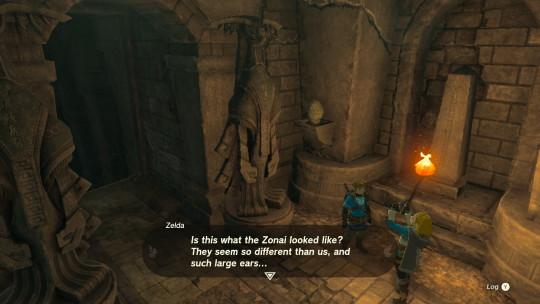

"How did the ruins of a civilization in the sky end up here beneath the castle?"
The mysterious tribe known as the Zonai have been truly revealed in The Legend of Zelda: Tears of the Kingdom, and there's so much to unpack! Let's highlight some of the new discoveries, and use this as a foundation to build new conversation around this thrilling topic.
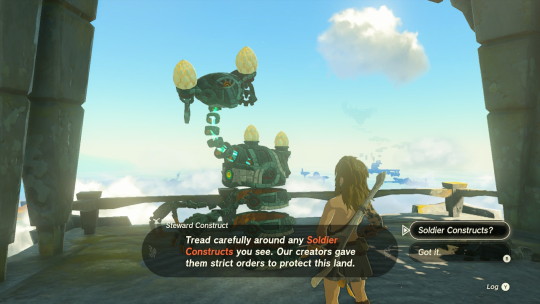
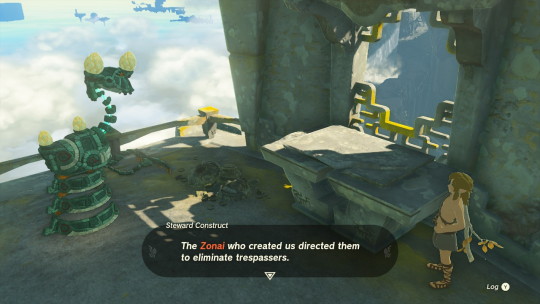
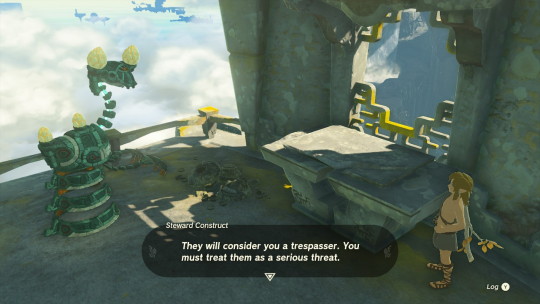

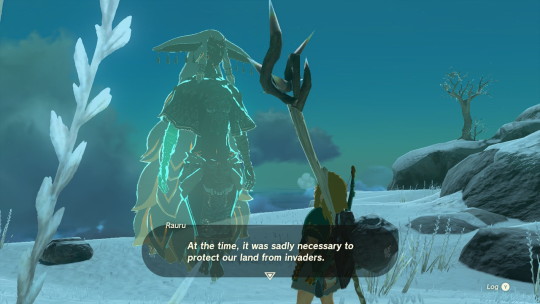
"Tread carefully around any Soldier Constructs you see. Our creators gave them strict orders to protect this land.
The Zonai who created us directed them to eliminate trespassers.
They will consider you a trespasser. You must treat them as a serious threat."


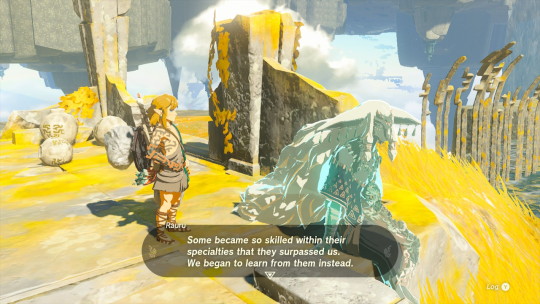

"Steward Constructs were the first to be built. After that, we crafted others suited to different roles.
Culinary Constructs, Maker Constructs… You'll find all sorts of them still active in this place."
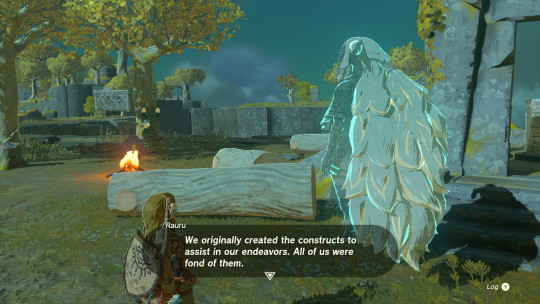


First up, there are multiple types of Constructs—autonomous machines built in a bygone era—and they are the creations of the Zonai. We find steward constructs, culinary constructs, maker constructs, soldier constructs and captain constructs across the sky islands and in Shrines of Light, as well as in other remote places. Despite the disappearance of their creators, the constructs diligently continue the duties that were given to them…


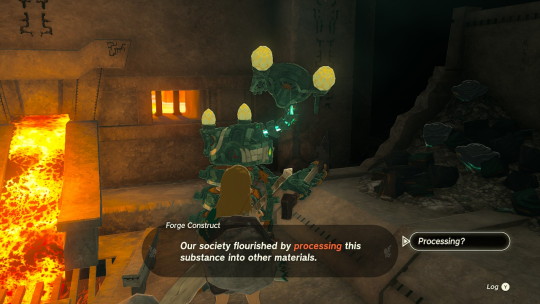

The society created by the Zonai in their heyday was built upon the use of a special ore called Zonaite, which was mined in the Depths far below the surface. With the properties of this ore, it could be processed into useful materials as well as an energy source to power their various devices. There's a myriad of Zonai devices which were built, all serving various functions; from fans and hydrants, to flying wings and lights, to wheels and hover stones, and so much more!
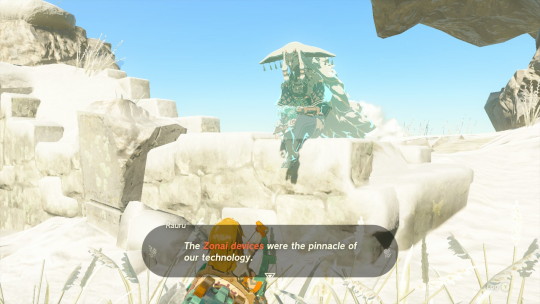


"The Zonai devices were the pinnacle of our technology.
We built an advanced civilization with them and flourished for many, many years."
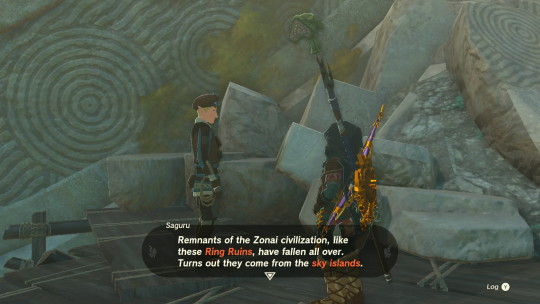
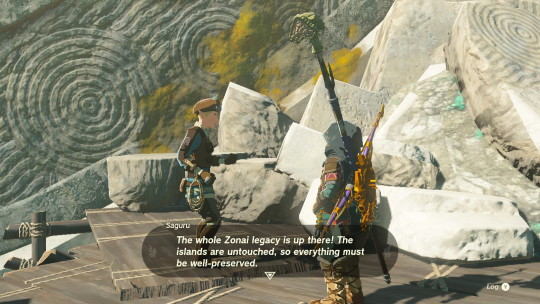



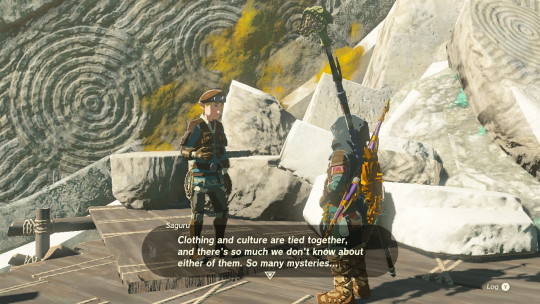
"Remnants of the Zonai civilization, like these Ring Ruins, have fallen all over. Turns out they come from the sky islands.
The whole Zonai legacy is up there! The islands are untouched, so everything must be well-preserved."
Part 2 to come~!
87 notes
·
View notes
Text
On death and its properties (visions on thanatology)
When one speaks of death, they are more often than not referring to the biological process that one's body goes through at a certain point of their life. There are a myriad of causes of death and yet, when someone dies, whether we are close to them or hear a stranger talking about the perished, our empathy towards them is kindled, and we are plagued by mental turmoil that may last for days, weeks, even years. Losses in our community shake us, especially when it is a loved one who passes away.
Death by old age, and by heart attacks, are the most prominent causes of one's passing. Suicide has progressively increased over the last decades - to which psychologists and sociologists (such as Émile Durkheim listing even 3 key reasons) have been trying to study the reasons that may cause an individual to take their own life.
When our biological functions cease, what happens to us both on Earth and afterwards is dependant on our beliefs, or the society we live in. In most modern societies, like our own, after an individual is formally considered to be dead, the funerary rites follow. Friends and relatives of the perished gather to be reminded of them one last time. In religious settings, after the prayers requesting for the defunct's peaceful rest are given, the corpse, placed inside a coffin beforehand, is lowered into a hole, being covered with dirt and being sealed under the ground. Per the defunct's will, however, the rites may be denied, or carried over with specific instructions. From there, the release of post-mortem chemicals, as well as insects, will finish off the remains.
As one would expect, the meaning of death varies according to each culture, and funerary rites are not universal. Anthropologist Bronislaw Malinowski gives us detailed information about the funerary rites of a Melanesian tribe:
"As soon as death has occurred, the body is washed,
anointed and adorned, sometimes the bodily apertures are filled,
the arms and legs tied together. Then it is exposed to the view
of all, and the most important phase, the immediate mourning
begins. Those who have witnessed death and its sequel among savages and who can compare these events with their counter-
part among other uncivilized peoples must be struck by the fundamental similiarity of the proceedings. There is always a
more or less conventionalized and dramatized outburst of grief
and wailing in sorrow, which often passes among savages into
bodily lacerations and the tearing of hair. This is always done in a public display and is associated with visible signs of mourning, such as black or white daubs on the body, shaven or dishevelled hair, strange or torn garments."(1)
As we can see, and as Malinowski himself states, the event of gathering to mourn over the defunct and the garments worn for this occasion is resemblant to the black colors normally worn by people attending a funeral in our developed societies. Malinowski also adds:
"The corpse, and with it the person of the dead one, is a potential object of horror as well as of tender love. Religion confirms the second part of this double attitude by making the dead body into an object of sacred duties. The bond of union between the recently dead and the survivors is maintained, a fact of immense importance for the continuity of culture and for the safe keeping of tradition."(2)
We are met with horror, shock, and a feeling of incredibility upon seeing a corpse, but at the same time we feel the perished's suffering and make sure we do not forget their time on Earth - that is one of the goals of funerary rites.
Now that we've explained what are funerary rites and how they work, it is time to introduce something that has been questioned, and answered, for millenia - the afterlife.
Various religions and myths have declared what happens after one's time is finished on Earth; interestingly, this seems to be somewhat of a common belief among the disparate developed rural/urban socities, and underdeveloped tribal societies. Christians, for example, believe that after death, one is transported to either Heaven or Hell, depending on their behavior while they were alive. Less acknowledgedly in this regard is the Limbo, a sort of "in-between" of these two places, where dwell those who have passed away without being condemned, but also not allowed to enter Heaven. This is similar to Ancient Greece's vision of the afterlife in that the dwelling place of the dead is Hades (synonymous with the greek god of the dead). During the funerary rites, a coin would be placed inside the defunct's mouth to serve as payment for Charon, the ferryman of the underworld. Charon's duty was to transport souls to Hades in a boat that crossed Styx, a river that served as a bridge between the Earth and the underworld. Those who failed to pay the toll would be condemned to wander along Styx for a hundred years before being allowed to enter Hades.
But what are the effects of death to those who witness it? We have seen that people, when faced with the death of a loved one or ally in community or beliefs, will perform adequate rites to ensure that the perished will be remembered after their passing. But some do not conform themselves with this. Finding it "unfair" that a member of their community is no longer among them, they may react violently against society, or themselves. When an individual is murdered by another, a friend of theirs quickly attempts to avenge them by acting in equal measure. Others, such as in the famous shakesperean tragedy Romeo and Juliet, are willing to put an end to their life in a desperate attempt to rejoin their loved one(s) in the afterlife. How ironic it is that love, a force that makes us live, may also make us willing to die...
Thanatology, the science that studies death and its effects, is a very underexplored subject. With gradual advancements and connections with other fields of study, we might be able to truly realize what death implies and what exists beyond it.
1, 2 - Bronislaw Malinowski - Magic, Science and Religion
#sociology#anthropology#social science#death#thanatology#philosophy#humanities#thoughts#funeral#rites#culture#mythology#religion#ancient greece#christianity#pantheism#spirituality
18 notes
·
View notes
Text
Islam and Modernity: Navigating Challenges and Embracing Opportunities
Exploring Islam’s Role in the Contemporary World
Islam’s presence in the modern era is multifaceted, encompassing a myriad of cultural, social, and technological advancements. It stands as a dynamic force shaping both individual lives and global thought, resonating with timeless values while adapting to the challenges and possibilities of the modern age.
Cultural Integration and Global Influence
Islamic culture, rich with diversity, art, and tradition, continues to influence global trends. From architecture to literature, art to fashion, the beauty and depth of Islamic heritage have found resonance in the contemporary world, fostering a sense of interconnectedness among diverse societies.
Quran (49:13) — “O mankind, indeed We have created you from male and female and made you peoples and tribes that you may know one another. Indeed, the most noble of you in the sight of Allah is the most righteous of you.”
Social and Ethical Framework
Islamic ethics, anchored in principles of justice, compassion, and egalitarianism, continue to offer guidance amid a rapidly changing world with a decay in social structures. It serves as a moral compass in addressing contemporary issues such as human rights, environmental stewardship, and societal harmony.
Hadith (Sunan Ibn Majah) — “The best of people are those who are most beneficial to people.”
The Challenges and Opportunities
Navigating the intersection of tradition and modernity presents both challenges and opportunities for Islamic communities worldwide. Adapting to technological advancements, evolving social norms, and global interconnectivity requires a delicate balance while preserving the core values of Islam.
During such times Islam has shown it’s ability to hold on to it’s foundational beliefs, held up by our Pillars of Islam and Faith.
Challenges of Misunderstanding and Stereotypes
Islam often grapples with misconceptions and stereotypes in a rapidly changing world. Addressing these misunderstandings and fostering intercultural dialogue becomes imperative in promoting mutual understanding and harmony.
In such times it’s vital we forgo concluding quick conclusions, fuelled by today’s appetite for quick content, and instead really look in depth, having deep discussions with others and foster an environment of curiosity and conversation.
Quran (49:6) — “O you who have believed, if there comes to you a disobedient one with information, investigate, lest you harm a people out of ignorance and become, over what you have done, regretful.”
Embracing Education and Innovation
The contemporary era offers unprecedented opportunities for Islamic education, scholarship, and technological advancements. Embracing innovation while staying rooted in Islamic principles can facilitate societal progress and contribute positively to the global community.
Hadith (Sunan Abi Dawud) — “Seeking knowledge is a duty upon every Muslim.”
Islam’s engagement with modernity showcases its adaptability and resilience. While facing challenges, it presents an invitation to embrace diversity, uphold ethical principles, and harness the potential of progress to create a world reflective of Islamic values — marked by compassion, justice, and wisdom.
For more articles like this and a collection of resources and information about Islam, visit our website www.howtomuslim.org
5 notes
·
View notes
Text
Strange City

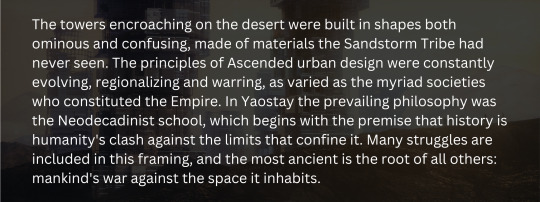


The towers encroaching on the desert were built in shapes both ominous and confusing, made of materials the Sandstorm Tribe had never seen. The principles of Ascended urban design were constantly evolving, regionalizing and warring, as varied as the myriad societies who constituted the Empire. In Yaostay the prevailing philosophy was the Neodecadinist school*,* which begins with the premise that history is humanity's clash against the limits that confine it. Many struggles are included in this framing, and the most ancient is the root of all others: mankind's war against the space it inhabits.
Our creations are an articulate scream of agency, rejecting the notion that how things are is how they must be. Architecture, therefore, should display the sublimity of human brilliance and celebrate our triumph over nature. Neodecadinism expresses this through structures which look impractical or even impossible, made real through mathematical precision and physical technicalities. Its buildings are often asymmetric and tall, with strange construction processes and obscure centers of balance—it's as though the whole city should topple.
The hunters knew none of this. The Sandstorm language didn't have the phonemes to pronounce "Neodecadinist." In this city they saw an unknown force that built without regard for the possible. Divine or demonic, they could not face it unprepared. When the hunters returned, preparations for an offensive began. The war that followed was a slaughter, an Ascended shout of Neodecadinist triumph over its land and all that lived there.
———
Yaldev is a sci-fantasy worldbuilding project by Ulysses Maurer, with art by Beeple. By looking at narratives, stylized loredumps, bad poetry and little details, we'll witness the story of a planet filled with magical power, the nation which tried to conquer it, this empire’s dramatic collapse and the new world which emerged in its wake. Along the way we'll meet the characters who live here, and we'll explore questions about nationalism, rationalism, the natural world and the quest to master it. For all stories in chronological order, check out the pinned posts at r/Yaldev!
#beeple#fantasy#scifi#worldbuilding#writing#everyday#short story#surreal#dystopia#dystopian#dystopian fiction#science fiction#science fantasy#sci fantasy#sci-fantasy#scifantasy#sf#sff#worldbuild#worldbuilder#worldbuilders#magic#d&d#dnd#canadian writers#escapism#lore#amwriting
4 notes
·
View notes
Text
Vaurogi, Children of Vaurog
Based off the HC/Canon I wrote/discovered rather recently.
The Vaurogi (or simply Vaurs) are a species of craggy-scaled bipeds that haunt the Naggarothi mountains of Black Spine. Occupying the caves and caverns of that frozen landmass, these creatures are not reptilian despite their scales and are set apart from the Snakemen of Ind and the Lizardmen of Lustria by a myriad of things. Namely, the blood of these beasts runs hot and they have neither the stoic brutality of the Children of the Old Ones or the malicious calculation of the Snakemen of Ind. The Vaurogi are more similar in temperament to the Beastmen that haunt the Empire. In fact, that is exactly what they are-- some far flung variant of those furred, brawny creatures of chaos, based from creatures different than, but as intelligent as humans.
However, the Vaurogi do not consider themselves the same or even remotely related to the Beastkin by origin. While beastmen care little for their beginnings, the Vaurogi are a prideful people who claim to come down directly and purposefully from the Chaos Powers, rather than being the result of an accident like the forest-beasts. The Beastmen are bastards and the Chaos Gods pay them little attention; the Vaurogi, meanwhile, claim the Serpent Mother Vaurog as their divine mother and the Chaos God Slaanesh as their divine father, knowing him as Slaatokan. Tz'arkan is their issue, called the Drinker of Worlds, and many powerful Cavelords claim lineage to that powerful daemon.
Twin-headed Vaurog is their primary god, a minor Chaos Power who was said to dwell in the deepest caves below Black Spine in ancient times. She craved souls fiercely and desperately and when her children could not manage her hunger, she returned to the sea of souls where she could consume as she liked. It is claimed that a rift that leads directly to the Chaos Realm was left in her wake, though no Vaurogi who has seriously sought it has come back alive.
While Vaurog is their primary god, some choose to venerate Slaanesh, viewing him as the mate of the Serpent Mother. They are often worshipped together as a pair and appeasements are given to the Pleasure Lord in the form of elf sacrifices, who are killed in a slow and agonizing fashion. Perhaps unexpectantly, Vaurogi are dexterous creatures and actively hunt down metals for personalization and to use in combat.
Physiology
Broadly, Vaurogs stood the height of an elf or taller, though they were broader and heavier by a significant margin. Their scales were thick enough that armor was redundant to most of them and they were known to boast an agility capable of keeping up with the lithe and lethal Dark Elves on which they preyed. They had Gorgonopsian heads and a neural spinal sail on the back. Females had smaller tusks and were somewhat slighter, but otherwise indistinct from the males.
Society
Like most Chaos Societies, Vaurog life was brutal. Due to the clime, weakness was not tolerated, and so the small or misshapen were taken into the deepest caverns to be consumed by Dread Maws, viewed as the manifestation of Vaurog or Slaanesh's endless craving for souls. A Vaurs first rivals were its siblings and it wasn't uncommon for these struggles to survive to end in fatalities. Vaurs who made it to maturity were to undertake the Rite of Offering, where they would strike out into the worlds in bands of six and return with a live catch for the Prince of Pleasure and Serpent Mother both. Sentient creatures were prized, with Elves being the most prized of all.
From there, a Vaur would serve as a warrior of the tribe and as a warrior, its primary jobs were to kill, protect, and multiply. The doing would please both their primary gods. A tribe would be run by a pair of Vaurogis who would be mated, with one often under the worship of Vaurog while the other claimed allegiance to Slaanesh, though some tribes could be ruled by two Slaaneshi and others by two Vaurogi. Vaur were polygynandrous, and this included the tribe leaders, who often sired and mothered children outside of the pair (though customarily the eldest of their children typically belonged to each other, giving them a marked advantage over younger siblings when it came to standing in the tribe. There was usually a strongest of this pair and they were called the Cavernlord or Cavelord.
Vaurs spoke a Variant of Dark Tongue called Spine Tongue (Vaurissh).
Military
Vauri - Young, unproven Vaurogi who have yet to embark on the Rite of Offering. Though untested, Vauri burn with the ferocity of youth and their un-honed battle fervor should not be underestimated.
Vaurog Warrior - Proven and tested, Vaurogs are considered adults with full rights within their respective tribes. Hard of scale and of heart, they are ferocious and unyielding in battle and highlight the inexperience of the Vauri by comparison.
Hard Scale - Hardscales are either born with or acquire through battle a particularly thick hide of scales that allows them to shrug off most wounds and outlast their kin. They are considered blessed by Vaurog, either at birth or for the privilege of a long life.
The Decorated - Hardscales that boast many battles and pillages worth of jewelry and accoutrement, as well as no few amount of scars. They are often the Cavernlord's lieutenants, but often enough, also eye their place in the pecking order.
Rime Scale ( Ice / Slaanesh / Vaurog ) - Pale Scaled Vaur are born with sway over magic, and are considered blessed by one or both of the Vaurogi's gods. Some remain white, their sail scales threaded through with blue, and are able to use the Lore of Ice. Some's sails shot through with red and gold, and go on to wield the Lore of Vaurog. Finally, some have sails colored purple or lavender or lilac and can wield the Lore of Slaanesh.
Dreadwyrm - The smaller 'cousins' to the much fiercer, much larger Dreadmaws, Dreadwyrms are hard to control and if they are hungry, this is all but impossible to achieve with might alone. When battle is anticipated, they are often starved days prior and then released onto the foe. Deadlier than other warbeasts, they burrow into the ground and then attack, allowing them to avoid enemy projectiles.
Mawcaller - Mawcaller are those view Vaurogs who brave the depths of Blackspine and wrestle juvenile Dread Maws into subservience. They then mount these terrible beasts and ride them into battle, but a Dread Maw juvenile can be lethal just like an adult and what is tame today can turn tomorrow.
Mawmaster - Mawmasters are Mawcallers who are old hands at the art of taming Dread Maws. They have outwitted and outmuscled their charges well into adulthood and now ride these terrifying creatures into battle. Mawmasters often share the title of Cavelord.
Tunneller - While Dreadmaws can be taught to enlarge a cavern system, they are fickle beasts and more than one tribe has known doom at one of these creatures deciding to turn on its handler mid-construction. Thus, Tunnellers are given this duty when available. Mutated before or at birth to be large, teams of these creatures can break bones and armor as easily as they can the face of mountain.
Cavernlord - The undisputed masters of a given tribe, Cavernlords dominate the burrows and can be told apart from their lessers by their large, colorful backsail and copious ornamentation. They rule through strength, or magical might, or both.
Lordsmate - The 'official' mate of the Cavernlord, and often the second strongest. Lordsmates have tremendous sway in burrow matters and will rule in lieu of the Cavernlord if they are absent for any reason.
Slaa'kaknoth - 'The Blessed of Slaanesh' Vaurogi who affect a notably serpentine aspect and are some shade of pale purple. Often, they are both male and female, as well. These Vaur are exceptionally smooth of scale and highly intelligent. While they share similar powers, no Slaa Rimescale has the magical might of a Slaa'kaknoth. At maturity, Slaa'kaknoth's make a journey into the Chaos Wastes and must return with the Khornate warrior as an Offering to Slaanesh.
Vaurog'knoth - 'The Blessed of Vaurog' Any Vaurogi born with two heads is considered blessed by the Serpent Mother herself. Powerful and strong, the Vaurog's aethyric might is greater than a Rimescale but lesser than a Slaa'kaknoth; one head is dedicated to the mystical while the other is concerned more with physical might , poison, and intimidations. Vaurog'knoths journey to Lustria at maturity and return with a suitable Saurian as their offering to Vaurog for her blessings.
#warhammer fantasy#slaanesh#dark elves#druchii#wip#The Legions of Excess (Slaaneshi Headcanon);#Vaurogi#Vaurog#longpost#CA hire me
2 notes
·
View notes
Text
Introduction to the Ufrajozlens
Ufrajozlen (plural noun: Ufrajozlens):
The Ufrajozlens are considered to be the most respectful and knowledgeable species in the all-seeing eyes of the Æylphitus. They have existed far longer than humanity and even the Awukhoziels themselves. Each Ufrajozlen tribal breed plays a specific role that helps to maintain their society and culture. They’re polytheistic, believing in a myriad of titans as well as supernatural beings who were seen as servants, guardians, and heralds. However, there are five titans who contributed to their eventual creation and flourishing culture. These are the Astonishing Sky-Giver, Lord of Raining Tears and Gentle Fog, Master of a Roaring Thunderstorm, Mistress of Starry Breath, and Frolicsome Cloud-Eater. They created them from the very quintessence of the vast skies, forming their bodies from soft clouds and letting the clear air fill their lungs. Due to this wondrous act, the Ufrajozlens consider the skies to be a very sacred place. They originally lived on Earth, enjoying the mundanity of their blissful ignorance and gracious gifts offered by nature. Unfortunately, their peaceful lives on Earth would be rudely interrupted by the arrival of the Awukhoziels. Most Awukhoziel tribes drove them away from their thriving homelands, prompting their titans to create floating islands that fill the endless skies and begin life anew. As of now, the Ufrajozlens are slowly going extinct for reasons that are currently unknown.
#writerscorner#writing#creative writing#trust me these fellas are interesting#funnily enough i was inspired by one piece#sky people#ancient humans#polytheist#polytheism#major deities#gods and goddesses#titans#supernatural beings#quintessence#sky#clouds#colonialism#going extinct#fictional species#fantasy#creation#multiverse#part 1/?#looking for moots#looking for mutuals#looking for friends#moots pls
2 notes
·
View notes
Text

Thinking about this question. I have many characters that work jobs of some sort but only one of them could be seen as a wage worker. But I think it'll be nice to flesh out the settings I have.
Wonderland has no characters that work jobs, at least not any characters central to the story. This is intentional. The characters themselves are meant to be abstractions of sex and gender and the world is somewhat inspired by porn games like corruption of champions. But also importantly: There is a significant fascist government in the setting and in a way these characters are not "allowed" to work. This is in part because of way that the story explores gender roles. In the same way that there were times historically women weren't "allowed" to work the trans and subversive characters central to the story are also not "allowed" to work or participate in mainstream society. (of course "allowed" is in parentheses because not being allowed to work often means being forced to work bad jobs. Women were allowed to work but they weren't allowed in good/high paying jobs. And similarly trans people today are not allowed in many of those jobs (and cis women and non-white people and.....))
Basically Wonderland is meant to be an exploration of gender and sexuality through the lens of fantasy porn. But to fully explore gender you have to also show the consequences and ways that people are treated for their gender and sexuality. Characters not having jobs in wonderland is intentional and deliberate for these reasons.
BABBAL my sci-fi story set in the body of a dead god. Wage labor is inherently different inside of the wound because people can just leave if they want to. The corpse gives freedom to do anything that someone can imagine and so one may not have to eat or sleep or drink or have shelter to survive. There are a myriad of ways that people in the wound live without any exchange, and some who are entirely dependent on constant exchange of some sort.
Two main characters in this setting have more traditional "laborer" dynamics which is Steph (hired as a researcher from an organization outside of the wound) and Wilwit (zombie that works as an executioner at a brothel). Steph is too much to get into in a post like this but Wilwit is interesting because he has a more traditional 9-5 style of job. His life is structured around a job and very importantly this is a lifestyle and job that he chose and chooses to do. There's a lot I can explore with Wilwit but one of those things is alienation from work and what it takes for someone to not be alienated from that. Especially in a setting where it is clear he is choosing to work for his own enjoyment and fulfillment I think he is a really interesting character.
Pockets would be my magical girl focused story. Faith is the main character and while she is not a wage laborer, she is a contractual worker. Specifically she is contractually obligated to work for the central religion of her world, as repentance for being a magical girl. The religion pays her what would be considered less than minimum wage for the work that she does. The story involves her denying the responsibility placed on her, and while it's more focused on religious and trans themes I think that there is overlap with wage labor and anti-capitalism.
??? an unnamed story that is ironically the most fleshed out of all of them. It's a traditional fantasy world and I often refer to it by the name of the two central characters, Muzi and Selina. The world itself leans anarchist, and while I want to eventually write stories about characters found in some of the central empires, most of the stories I've written are on the outer edges of the world where various groups of peoples live anarchist lifestyles. the two central characters are traveling members of a troupe, the people of the troupe are primarily members of a nomadic tribe who had to leave the trails and pathways they call home.
Muzi and Selina work in part for this troupe, and also as hired mercenaries. Contract workers would be the closest thing we have to what they are, I suppose, but the term doesn't fit them particularly well. They are disenfranchised and the troupe primarily barters for food and supplies and so money is not a high priority for them. Mercenary work helps subsidize them alongside the creation of goods from craftsmen in the troupe and performances and entertainment that they charge for in more populated areas. It is a nomadic commune, if I had to state what it is through my limited knowledge of these sorts of things.
#my writing#creative#this was mostly meant as an exercise to help flesh out these settings and get a clearer idea of what I wanted by writing them.
3 notes
·
View notes
Video
youtube
“Brown eyed Girl” GH Covers Van Morrison #Acoustic #NewLiveMusicVideo #C...
“WHAT’S UP WITH THE LADIE’S OBSESSION WITH ATTRACTION & THE MEN’S OBSESSION WITH POWER???”
Well here it is in the Big, oh so cold and without detail and nuance Picture! Here it is in relation to the common Purpose & Meaning of Life for all the Naked Apes we call Humans!
The more attractive the female can be, in oh so many ways, the more likely she is to mate with the best genetics possible! It is solid Evolution! That’s the big one. But also the more esteem and thus ranking she will achieve with her peers & society in general which results in the best chances of survival, personal development & thus Evolution for her & her offspring.
The man on the other hand inherently knows that power is the route to the best possible capture & conquest so to speak, as in sperm penetrates egg! This ultimately results in the same thing the ladies want, ie. to procreate with best genetics possible!
The myriad of details involved in this process are what you hear in all these Sad Country Loves Songs we sing!
But at the end of the day we should always keep in mind this Big Picture or foundation of just exactly what in the hell we are all doing here on Earth!
Harmonious & Synergistic with Mother Nature & Spirituality we are trying to EVOLVE: Our SELVES, Our BRAIN and ultimately our DNA which includes: FAMILY, TRIBE & SPECIES.
We do this via the Creative Growth & Development we employ: 1. SURVIVING 2. PROCREATING 3. EVOLVING, which are the foundational components of our Evolution Process!
So, why cain’t I free your doubtful mind and melt yer cold, cold heart!
“3 Chords & The Truth!”
“The Evolution Connection!”
Griffinheart @ Patreon
ADVICE COLUMN-COUNSEL
ADVANCED PSYCHOTHERAPY FOR ADVANCED BRAIN FUNCTION!!!
“All Questions Answered!”
#HEALTH
#MENTALHEALTH
#ANXIETY
#DEPRESSION
0 notes
Text

Some initial design choices for the Forrad brothers cuz I've been focussing more on the Myriad Tribe and the assassin squad as I'm planning to try and write Niv's story (finally. After 4 years)
Some information about them under the cut!
Bendik Forrad is the older of the two brothers and is Niv's adoptive father. He found the boy in a burning ship as a newborn, with his parents no-where to be found. He had assumed they had perished in the fire and sunken to the bottom of the ocean, so he had decided to take the infant under his own wing to raise to become a successful member of the Myriad Tribe.
Bendik is a very strict parent (if you can even call him a parent) and due to a fear of bonding with others, not very emotionally available. He lost an older sibling bc of the assassin training program as a child and still has a lot of issues left over from it, resulting in the way he is as an adult. Still, he's regarded as a highly successful individual, being a part of the council and often being told he should challenge the current chief to become chief himself. It is quite unknown if he's actually gonna do this
He, his little brother Ludvig, and Niv all live together in the same hut and due to this forced proximity, he and Ludvig are closer than expected. Bendik still feels some sort of responsibility to his brother, certainly after Ludvig's difficulty entering adulthood
Ludvig Forrad, in return, is quite the bitter person. He failed his first assassin job as a teen and the guilt and shame that has brought him, hasn't faded yet. His whole life, he had been praised and had been told he'd become the greatest of his generation, but after his failure, all society would talk about, was his one mistake.
He's not exactly a loving uncle to Niv, being rather suspicious of this rascal of a boy and very distrusting of his capabilities. Ludvig believes Niv doesn't fit into the Myriad Tribe, but Bendik would kill him if he ever told him that. Still, Niv reminds him of the past that keeps haunting him over and over again - something in those eyes and in that way of speaking triggers him time and time again, causing in Ludvig often taking his anger out on the boy and leaving Niv terrified of what the man is capable of
Ludvig is, in fact, one of the most skilled assassins of the Myriad Tribe, but is never taken seriously bc of his past failures (he's very angy about that)
#the thing with these two brothers is#theyre not even villains#theyre antagonists#standing between niv and his goals#which is what's so interesting about them#it's only after niv gets free that they actively become villains (well. ludvig was one in his teens but that isn't exactly relevant here)#bendik in particular doesn't know if he loves his adoptive son or not#seeing as he's not exactly allowing himself to love or get attached bc they can die from the myriad tribe's extreme way of living#man's emotionally repressed af and meanwhile ludvig only feels rage towards a past he cannot change#and with niv being in the picture... it's a miracle he hasn't succumbed yet if these are his only parental figures#poor baby boi#i really enjoy thinking about this dynamic and the way the forrad brothers have been shaped by their society#it gives them such a deep sense of character#theyre victims in their own rights but make niv a victim too bc of the same reasons#anyways#im excited to finally be developing this in full#httyd#how to train your dragon#oc#artinandwritin's art#bendik forrad#ludvig forrad
5 notes
·
View notes
Text
Unlocking the Beauty of Long Hair: A Stock Photo Journey
Long hair has long been associated with beauty, elegance, and individuality. From flowing locks cascading down the back to intricately braided styles, there's something inherently captivating about a mane that stretches to impressive lengths. In the world of stock photography, long hair serves as a versatile subject, capable of conveying a myriad of emotions, themes, and concepts.
In this blog post, we'll delve into the enchanting world of long hair stock photography, exploring its diversity, versatility, and the myriad of ways it can enhance your creative projects.
1. Versatility Personified
One of the most remarkable aspects of long hair stock photos is their versatility. Whether you're looking to evoke a sense of romance, power, innocence, or mystery, long hair can effortlessly adapt to suit your vision. For romantic-themed projects, images of flowing locks catching the light can add an ethereal and dreamy quality. On the other hand, long hair styled in sleek, sophisticated updos exudes confidence and professionalism, making it perfect for corporate or business-related content.
2. Cultural Richness
Long hair holds deep cultural significance in many societies around the world. From the intricate braids of African tribes to the flowing tresses of Indian brides, each culture has its own unique interpretation of beauty and style when it comes to hair. Stock photos featuring long hair can capture these cultural nuances, offering a window into the diverse tapestry of human expression. Incorporating such images into your projects not only adds visual interest but also promotes cultural appreciation and understanding.
3. Symbolism and Metaphor
In the realm of visual storytelling, long hair can serve as a powerful symbol or metaphor. It can represent freedom, rebellion, sensuality, or even spirituality, depending on the context in which it's portrayed. Images of a woman tossing her hair in the wind might symbolize liberation and breaking free from societal norms, while a close-up shot of hair adorned with flowers could evoke themes of natural beauty and harmony with the environment. By harnessing the symbolic potential of long hair, you can imbue your projects with deeper meaning and resonance.
4. Timeless Elegance
Long hair has stood the test of time as a timeless symbol of femininity and elegance. Throughout history, artists, poets, and writers have been inspired by the allure of cascading locks, immortalizing them in paintings, literature, and music. In the world of stock photography, long hair continues to captivate audiences with its timeless appeal. Whether it's a vintage-inspired portrait reminiscent of old Hollywood glamour or a contemporary fashion shoot featuring bohemian-inspired hairstyles, long hair exudes an undeniable sense of elegance and grace.
5. Inspiration for Creativity
Finally, long hair stock photos serve as a boundless source of inspiration for creatives across various industries. Whether you're a graphic designer, marketer, blogger, or content creator, incorporating images of long hair into your projects can spark creativity and elevate your work to new heights. From web design and social media posts to advertising campaigns and editorial layouts, the possibilities are endless when it comes to harnessing the beauty and versatility of long hair imagery.
In conclusion, long hair stock photography offers a wealth of opportunities for creative expression, cultural exploration, and storytelling. Whether you're aiming to evoke a specific emotion, convey a particular message, or simply add visual interest to your projects, long hair serves as a versatile and captivating subject that never fails to leave a lasting impression. So why not unlock the beauty of long hair in your next creative endeavor? The possibilities are as limitless as the flowing strands themselves.
0 notes
Text
Ana Haib Misr, the Pharaohs, the Pyramids, the Sphinx, the Mediterranean, the Red Sea and so on...
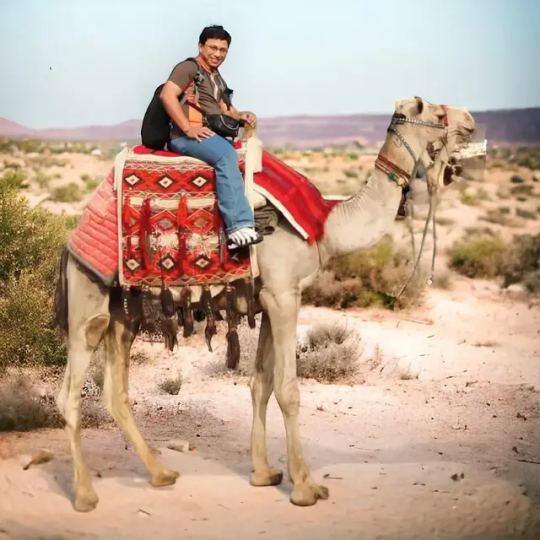
As I settled into my seat on Egypt Air, bound for Cairo, I couldn't shake the excitement coursing through me. It wasn't just another business trip; it was the beginning of a new chapter. Glenmark Pharmaceuticals was expanding into Egypt, and I was about to embark on my first visit to this ancient land.
The flight from Khartoum had been smooth, but as we descended toward Cairo, the sight of the sprawling city below took my breath away. The pyramids stood proudly amidst the urban landscape, a testament to Egypt's rich history.
Upon landing, I was greeted by the warmth of the Egyptian sun and the hustle and bustle of Cairo International Airport. As I made my way through customs, I couldn't help but feel a sense of anticipation for what lay ahead.

My first meeting in Egypt was with potential business partners who shared the vision for bringing Glenmark Pharmaceuticals to the Egyptian market. Despite the me knowing 'Shoya Shoya' Arabic, the passion for our shared goal transcended any linguistic differences.
In between meetings, I took the opportunity to explore Cairo's Bazaars, sampling local cuisine in restaurant like Gaad and soaking in the sights and sounds of this bustling metropolis. From the bustling Khan el-Khalili Bazaar to the serene banks of the mixed Nile, every corner of Cairo seemed to hold a new adventure.
But it wasn't all business and exploration. I also took the time to visit the iconic pyramids of Giza and Citadel of Salahuddin marveling at the architectural wonders that have stood the test of time. Standing in the shadow of these ancient monuments, I couldn't help but feel a sense of awe at the ingenuity of the ancient Egyptians.
As my time in Egypt drew to a close, I couldn't help but reflect on the journey that had brought me here. From pharmaceutical company in India to the bustling streets of Cairo, it had been an incredible adventure. And as I boarded my flight back to Mumbai, I knew that this was only the beginning of my love for Misr.
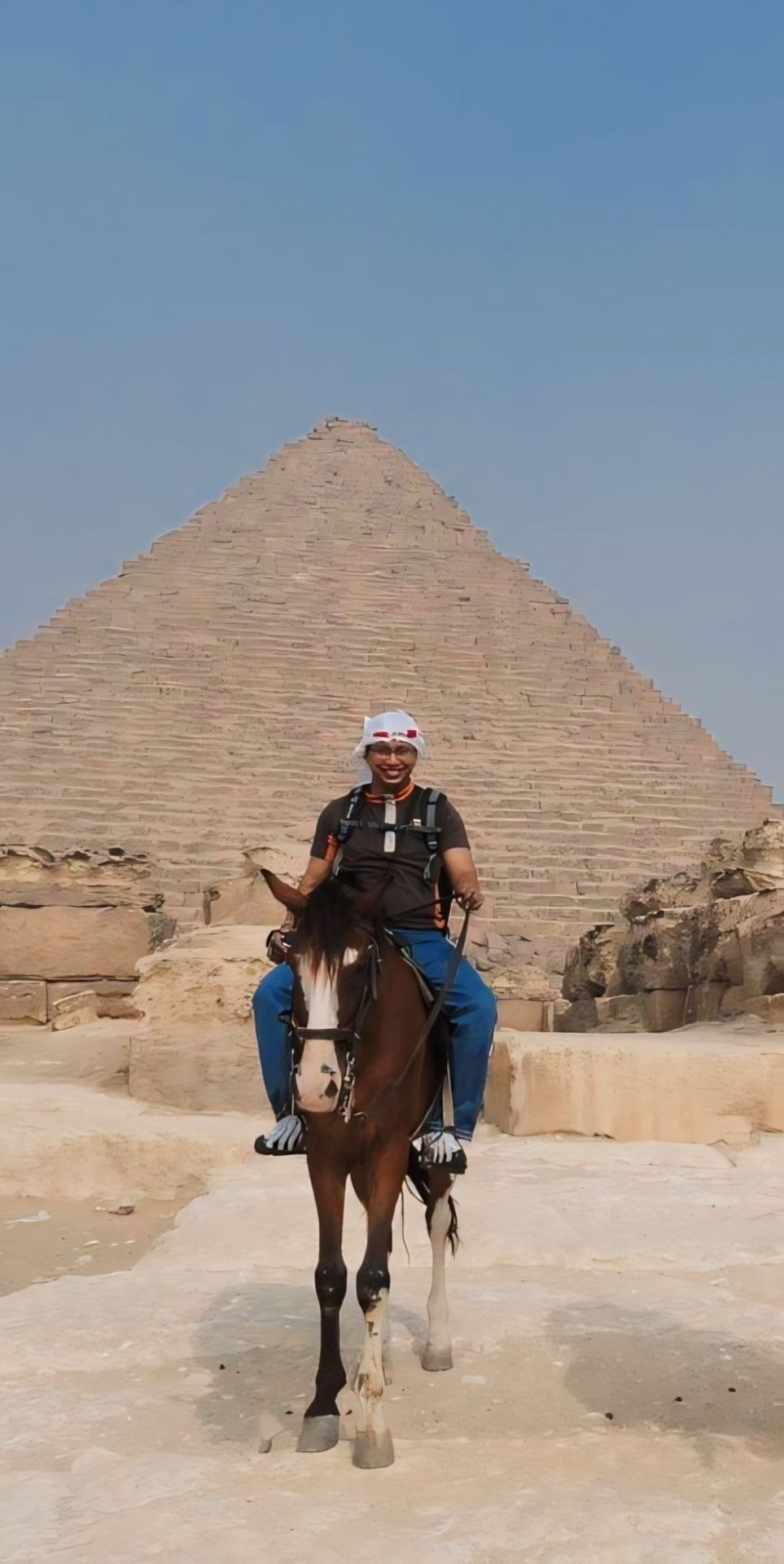
Ana Haib Misr...
Egypt is divided into 27 governorates, which are the top administrative divisions. These governorates are further divided into regions, provinces, and districts. As for tribes, Egypt has various indigenous tribes, but they are not officially recognized administrative divisions like governorates or provinces. Some tribes in Egypt include the Bedouin tribes of the Sinai Peninsula and the Beja tribes in the eastern desert region. These tribes often have their own social structures and cultural traditions but are not officially recognized as administrative divisions.
Misr, known for its rich history and diverse populace, boasts a multifaceted demographic landscape. Within its bustling cities and serene rural areas, a tapestry of cultures intertwines, reflecting centuries of migration and settlement. The metropolises teem with a cosmopolitan blend of inhabitants, ranging from indigenous Misrians to expatriates drawn by its economic opportunities. This urban mosaic is further enriched by communities hailing from across the globe, contributing to the vibrant fabric of Misrian society. Amidst this diversity, a myriad of languages resonate through its streets, echoing the varied origins of its denizens.
In contrast, rural Misr paints a different portrait, characterized by agrarian traditions and tight-knit communities. Here, familial bonds run deep, shaping social structures and customs passed down through generations. While modernization has touched even the most remote villages, preserving heritage remains a cornerstone of rural life. Traditional festivities and rituals continue to punctuate the rural calendar, fostering a sense of continuity amidst a changing world.
Despite the disparities between urban and rural environments, common threads unite Misrians across geographic divides. Shared values of hospitality, resilience, and communal solidarity form the bedrock of Misrian identity, transcending demographic distinctions. As Misr navigates the complexities of globalization and demographic shifts, its people remain bound by a collective history and a shared vision for the future, embodying the spirit of unity amidst diversity.
Home to several notable towns and cities, each with its own unique history, culture, and attractions.
Cairo: The capital and largest city of Egypt, known for its bustling streets, ancient landmarks like the Pyramids of Giza and the Sphinx, as well as the vibrant markets and museums.
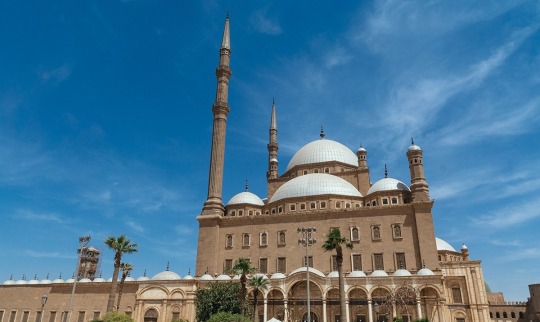
Alexandria: A historic port city on the Mediterranean coast, famous for its ancient library, Catacombs of Kom el Shoqafa, and picturesque seafront.
Luxor: Often referred to as the world's greatest open-air museum, Luxor is home to the Karnak and Luxor temples, the Valley of the Kings, and the Valley of the Queens, making it a must-visit for history enthusiasts.
Aswan: Situated on the Nile River in southern Egypt, Aswan is known for its beautiful riverside setting, Philae Temple, High Dam, and the serene Elephantine Island.
Sharm El Sheikh: A popular resort town located on the southern tip of the Sinai Peninsula, renowned for its crystal-clear waters, coral reefs, and vibrant marine life, making it a paradise for snorkelers and divers.
Hurghada: Another Red Sea resort town, Hurghada offers excellent diving and snorkeling opportunities, as well as vibrant nightlife and luxurious resorts along its coastline.
Dahab: A laid-back coastal town known for its relaxed atmosphere, stunning beaches, and world-class diving spots, including the famous Blue Hole.
History and Tradition in Health and Lifestyle:
Traditional, herbal, and natural medicines have a significant influence in Egypt, deeply rooted in the country's history and culture. Egyptians have relied on traditional remedies for centuries, often blending ancient practices with modern healthcare. Herbal medicine, in particular, plays a crucial role, with many Egyptians using plants and herbs for various ailments, drawing from knowledge passed down through generations. Additionally, natural remedies such as honey, garlic, and aloe vera are commonly used for their purported medicinal properties. While modern medicine is widely available in Egypt, traditional and herbal medicines continue to be valued for their accessibility, affordability, and perceived effectiveness in treating certain health conditions. However, it's essential to note that the efficacy and safety of these remedies may vary, and it's important for individuals to consult healthcare professionals for proper guidance and treatment.
Natural ingredients have deep cultural significance in Egypt, where ancient beauty practices often revolved around natural elements like honey, aloe vera, and various plant oils. These ingredients have continued to influence modern Egyptian beauty products, with consumers valuing their perceived purity, efficacy, and connection to tradition. Commonly used natural ingredients in Egyptian beauty products include rose water, black seed oil, and hibiscus extract, renowned for their skin-nourishing properties. Additionally, the revival of traditional practices, such as using ingredients like milk and honey in skincare routines, has further fueled the popularity of natural beauty products among Egyptians. Overall, the influence of natural ingredients remains strong in Egypt, reflecting a cultural appreciation for holistic beauty practices that prioritize natural elements.
The Unani Link:
The presence of Unani medicine in Egypt can be seen in various ways.
Egypt has been a center for learning and medical advancement for centuries. During the Islamic Golden Age, scholars in Egypt contributed significantly to the development and dissemination of Unani medicine.
Unani medicine is still taught and practiced in Egypt, with institutions offering education and training in this traditional healing system. Students can pursue degrees and certifications in Unani medicine at universities and specialized institutes.
Unani medicine coexists with modern healthcare in Egypt, with some practitioners offering Unani treatments alongside conventional medical care. This integration reflects the country's recognition of the value of traditional healing systems in complementing modern medicine.
Unani remedies and practices are accessible to the Egyptian population, with herbal remedies, dietary recommendations, and lifestyle advice often integrated into healthcare practices. Many Egyptians value the holistic approach of Unani medicine, which considers the interconnectedness of the body, mind, and spirit.
Unani medicine is deeply ingrained in Egyptian culture and traditions, with many families passing down knowledge of herbal remedies and healing practices through generations. This cultural influence contributes to the continued relevance and acceptance of Unani medicine in Egyptian society.
The Size:
In 2024, the revenue in the OTC Pharmaceuticals market in Egypt amounts to US$1,503.00m. It is projected to experience an annual growth rate of 9.64% (CAGR 2024-2028). Among the various market segments, the largest one is Vitamins & Minerals, which recorded a market volume of US$549.20m in 2024.
In Egypt, the revenue in the Cosmetics market is projected to reach US$895.20m in 2024.
It is expected to grow annually by 7.53% (CAGR 2024-2028).
When considering the population size, per person revenues in Egypt are estimated to be US$7.82 in 2024.
Looking ahead to 2024, 86% of sales in the Cosmetics market will be attributed to Non-Luxury.
The cosmetics market in Egypt is experiencing a surge in demand for natural and organic products, driven by consumer preference for sustainable and eco-friendly options.
The road ahead:
Therefore, as I reflect back on my inaugural journey to Misr, I am captivated not only by its rich history and mesmerizing beauty but also by the promising prospects it presents, particularly in the realms of traditional healthcare and beauty. My experiences have fueled my ambition to delve deeper into this vibrant opportunity, recognizing Misr as the next frontier for exploration.

0 notes
Text
Divination, Mysticisms & Enlightening Impacts on you

Seeking knowledge of the future or the unknown by supernatural means
Welcome to the mystical realm where ancient wisdom meets modern technology! If you are curious about divination and the fascinating world of spiritual-based eProducts, you're in for a transformative journey. In this comprehensive guide, we will explore the art of divination, its historical roots, various methods, and how cutting-edge technology has brought these ancient practices into the digital age.
The Essence of Divination:
At its core, divination is the age-old practice of seeking insights, guidance, and revelation through mystical means. It taps into the belief that hidden forces or energies can provide valuable information about the past, present, and future. Throughout history, divination has been a universal thread connecting cultures across the globe, from ancient civilizations to contemporary societies.
Historical Roots:
Divination has ancient roots dating back to the earliest human civilizations. The Chinese developed the I Ching over 3,000 years ago, while the ancient Egyptians relied on scrying methods, such as reading patterns in smoke or water. The Greeks consulted oracles like the famous Oracle of Delphi, and Native American tribes utilized nature-based divination techniques.
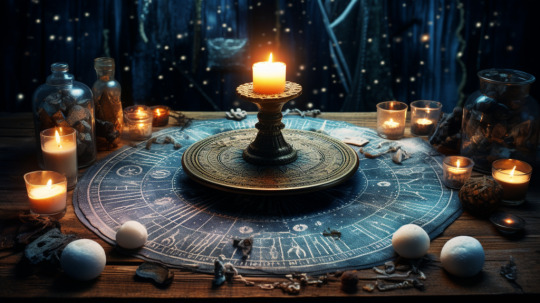
Diverse Methods:
The methods of divination are as diverse as the cultures that practice them. Some popular forms include:
Tarot Cards: A deck of cards with intricate symbols and archetypes used for intuitive readings.
Runes: Ancient alphabets carved on stones, each with its own symbolic meaning.
Astrology: Examining celestial positions to gain insights into an individual's personality and future.
Pendulum Divination: Using a suspended pendulum to answer yes or no questions.
Numerology: Analyzing numbers to reveal hidden meanings and connections.
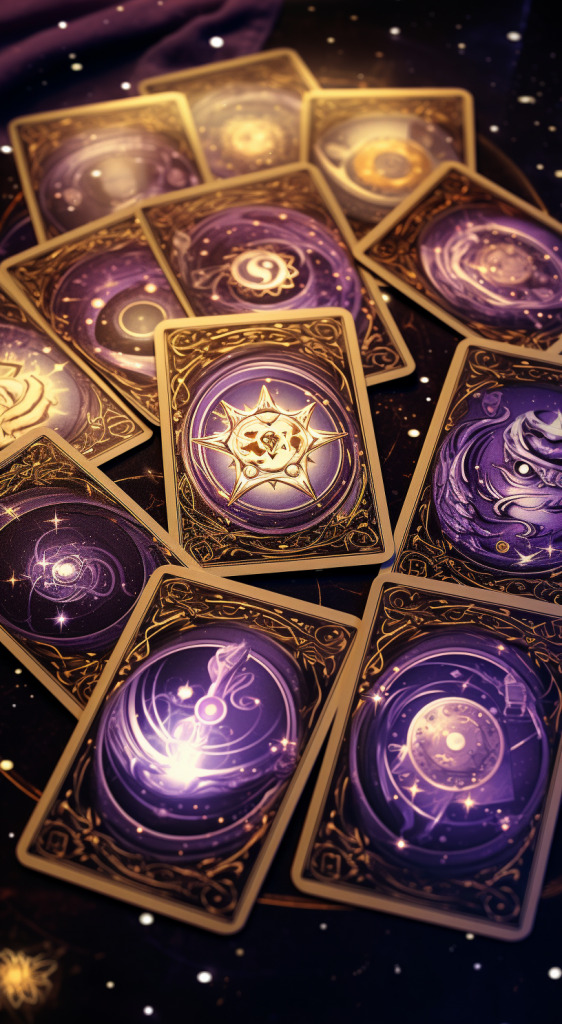
Spiritual-Based eProducts:
In the digital age, the ancient art of divination has found new expression through Spiritual-Based eProducts. These products leverage technology to bring mystical insights, guidance, and healing to individuals worldwide. One might call it Technomancy as energies are making new connections over new forms of directed energies.
Accessibility and Convenience:
Spiritual-Based eProducts break down geographical barriers, allowing users to access divination tools and guidance anytime, anywhere. With just a smartphone or computer, individuals can connect with the spiritual realm, gaining clarity and understanding at their convenience.
Diverse Platforms:
The Science of Divination:
While divination is steeped in mysticism and spirituality, the effectiveness of these practices can be approached from a psychological perspective. Many believe that the power of divination lies in the interpretation and introspection it inspires. Here's how divination can be understood through a scientific lens:
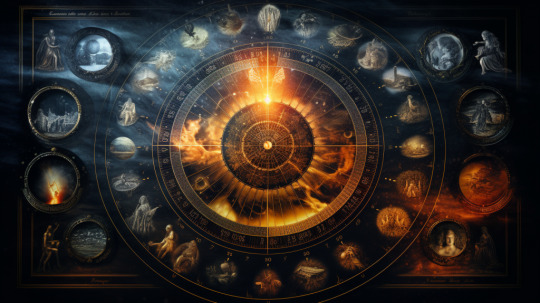
Symbolic Representation:
Spiritual tools often utilize symbols, archetypes, and metaphors that tap into the subconscious mind. The interpretation of these symbols can trigger personal insights, helping individuals access their inner wisdom and intuition.
Self-Reflection:
Engaging in divination encourages individuals to reflect on their thoughts, feelings, and life circumstances. The process of contemplating the messages received can lead to greater self-awareness and personal growth.
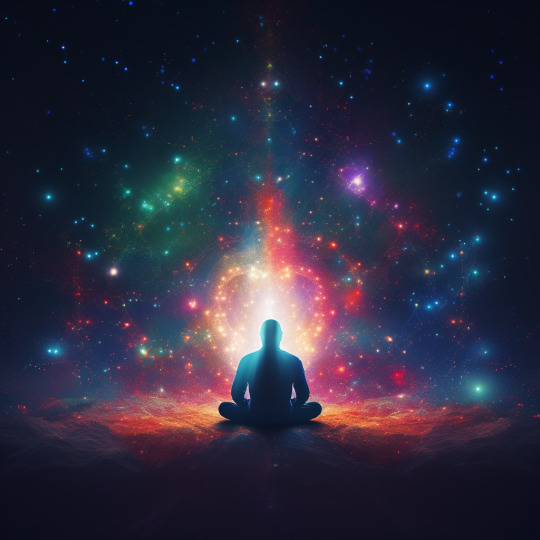
Positive Psychology:
Divination can have a positive impact on mental well-being by promoting optimism, resilience, and a sense of purpose. The guidance provided, even if symbolic, can inspire individuals to approach challenges with a more positive mindset.
Choosing the Right Spiritual-Based eProduct:
With a myriad of options available, selecting the right Spiritual-Based eProduct for your journey is crucial. Consider the following factors when exploring the diverse world of digital divination found on apps such as Discord, TikTok, & YouTube.com
Intuitive Interface:
Choose an eProduct with an intuitive and user-friendly interface. Navigating through the platform or application should be seamless, allowing you to focus on the divination experience rather than struggling with technicalities, such as which devices you can use.

Expertise and Authenticity:
Look for eProducts that collaborate with experienced spiritual advisors or practitioners. Authenticity is key, and the guidance provided should resonate with the rich traditions of divination.
Customization Options:
Opt for eProducts that offer customization options based on your preferences and needs. Whether it's a personalized tarot spread or an astrology reading tailored to your birth chart, customization enhances the relevance and accuracy of the insights gained.
User Reviews and Testimonials:
Research user reviews and testimonials to gauge the experiences of others who have used the Spiritual-Based eProducts. Positive feedback and shared success stories can provide insights into the effectiveness and authenticity of the platform.
Ethical Considerations:
While exploring the world of divination and Spiritual-Based eProducts, it's essential to approach these practices with a sense of responsibility and ethical awareness.
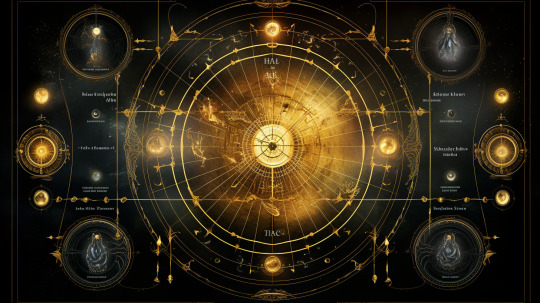
Informed Consent:
Before using any divination tool or seeking guidance from a spiritual advisor, ensure that you provide informed consent. Understand the nature of the service, its limitations, and the potential impact on your well-being.
Respect for Traditions:
Acknowledge and respect the cultural and spiritual traditions from which divination practices originate. Be mindful of the sacred nature of these traditions and approach them with humility and openness.
Integration with Professional Advice:
Divination can be a valuable tool for self-reflection and guidance, but it is not a substitute for professional advice in areas such as mental health, finance, or legal matters. Use divination as a complement to, rather than a replacement for, expert guidance.
In Conclusion:
Embarking on a journey of divination through Spiritual-Based eProducts opens the door to a realm of ancient wisdom, self-discovery, and spiritual growth. As you explore the diverse methods and platforms available, remember that the power lies not only in the mystical but also in the transformative effects it can have on your perspective and understanding of life.
Whether you are drawn to the symbolism of tarot cards, the ancient wisdom of runes, or the cosmic insights of astrology, the digital age has made these practices more accessible than ever. With responsible use and a respectful approach, you can unlock the mysteries of divination and embark on a journey of personal and spiritual evolution with the guidance of cutting-edge Spiritual-Based eProducts.
#divination#spiritual disciplines#spirituality#mysticism#spiritual#eproducts#tarot cards#tarot reading#tarot witch#tarot#appointmentscheduling#pendulum readings#witchcraft#witches#magick#wicca#wiccan
0 notes
Text
The Versatility and Beauty of Braided Wigs: A Comprehensive Guide"
Introduction
Braided wigs have become a popular and trendy option for those looking to change their hairstyle without committing to time-consuming and potentially damaging braiding processes. In this comprehensive guide, we will explore the world of braided wigs, from their history and cultural significance to the different styles available, maintenance tips, and the advantages of using them. Whether you're a seasoned wig-wearer or new to the world of alternative hairstyles, this article will provide you with all the information you need to make an informed decision about incorporating braided wigs into your personal style.
BUY NOW : Braided Wig
Chapter 1:
The History and Cultural Significance of Braided Wigs (200 words) Braids have been a part of human culture for thousands of years, symbolizing different things in various societies. In Africa, braids hold cultural and historical significance, often representing one's social status, tribe, or even age. In more recent years, braided wigs have gained popularity as a fashion statement, drawing inspiration from these historical roots. This chapter will delve into the history and cultural significance of braids and how braided wigs have become a modern-day reflection of this rich heritage.
Chapter 2: The Many Styles of Braided Wigs
Braided wigs come in a myriad of styles, each offering a unique look and feel. From box braids and cornrows to Senegalese twists and faux locs, the diversity of braided wig options allows you to experiment with different looks. We will explore the most popular braid styles and discuss how to choose the one that suits your personality and desired aesthetic.
Chapter 3: Advantages of Braided Wigs
Braided wigs offer a range of benefits that make them a compelling choice for many individuals. They provide a protective hairstyle option, help you save time and effort on daily hair routines, and give you the freedom to change your look as often as you like. This chapter will outline the advantages of using braided wigs and why they are an excellent choice for those seeking a versatile and low-maintenance hairstyle.
Chapter 4: Maintaining Your Braided Wig
Proper maintenance is crucial to ensure your braided wig stays in excellent condition and continues to look its best. In this chapter, we'll provide a step-by-step guide on how to maintain and care for your braided wig, including washing, styling, and storing tips. With the right care, your braided wig can last a long time, saving you money and reducing the environmental impact associated with frequent hair changes.
Conclusion
In conclusion, braided wigs are more than just a stylish accessory; they're a reflection of culture, history, and personal expression. With the variety of styles available and the convenience they offer, braided wigs have become a go-to choice for people of all backgrounds. By understanding their history, styles, advantages, and maintenance, you can confidently embrace the world of braided wigs and enjoy the freedom to experiment with your look, all while protecting and maintaining the health of your natural hair. Whether you're looking for a temporary change or a long-term solution, braided wigs are a fantastic option to consider.
1 note
·
View note
Text
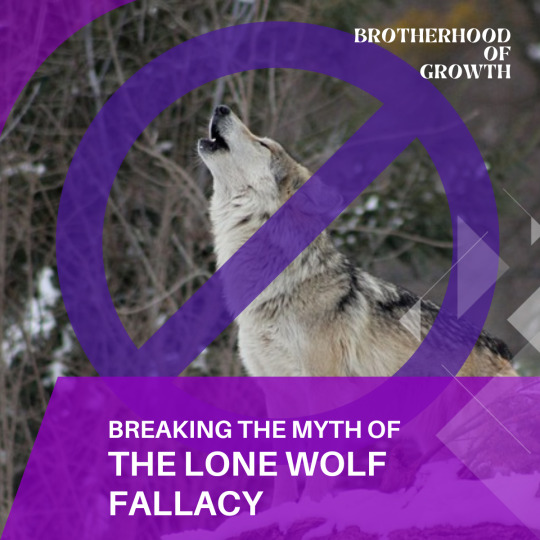
The Myth of the Lone Wolf: The Power of Unity Over Solitude
In modern folklore, the image of the lone wolf has been romanticized — a lone creature, strong and independent, forging its path through the wilderness. Society, especially towards men, often peddles this lone wolf fallacy. It's a narrative that says: "Stand alone, trust no one, and you won't get hurt." It tells men that they are invulnerable in isolation, and vulnerability is equated to weakness.
The visual is poetic: a man standing against the world, self-reliant and indomitable. They're told to look in the mirror, repeat affirmations of their strength, and take pride in their solo journey. "He who flies solo has the strongest wings," they say. But does he truly?
While self-reliance and independence are valuable traits, the myth of the lone wolf ignores the innate human need for connection, community, and collaboration. No matter how strong the individual, there's an inherent strength found in numbers, in bonds, in shared experiences and mutual support.
Strength in Community: Throughout history, humans have thrived in groups. Communities offer support, shared resources, collective knowledge, and a safety net during challenging times.
Emotional Growth: Emotional intelligence and empathy are fostered through interactions. By connecting with others, sharing vulnerabilities, joys, and sorrows, we grow emotionally and mentally.
Shared Wisdom: No individual has all the answers. In tribes, communities, and teams, diverse experiences and perspectives combine, leading to better solutions, ideas, and understanding.
Protection from Isolation: Loneliness and isolation can have detrimental effects on mental health. By embracing community, we shield ourselves from these adverse effects and find a space of mutual understanding and acceptance.
Believing in the lone wolf fallacy deprives one of the rich tapestry of shared human experience. It's okay to lean on others, to seek advice, to share burdens. It doesn't make one weak; it makes one human.
To all the men out there: It's okay to seek your pack, your tribe. In unity, there's not just strength, but also growth, understanding, and genuine connection. Shed the weight of the lone wolf myth, and embrace the power of unity. You're not less of a man for wanting to be part of something bigger than yourself. In fact, that very desire enriches your journey and allows for a more profound experience of life's myriad facets.
#brotherhood of growth#brotherhood#lone wolf#tribe#find your tribe#growth in numbers#tribal#tribal combat#BrotherhoodOfGrowth#MensTribe#HolisticWellbeing#PersonalGrowthJourney#EmpoweredMen#YearlyRetreat#MensSupportGroup#TribeBonding#MensEmpowerment#GrowthCommunity#MensWellbeing#InnerStrength#BrotherhoodRetreat#EmotionalGrowth#MenUnite
1 note
·
View note